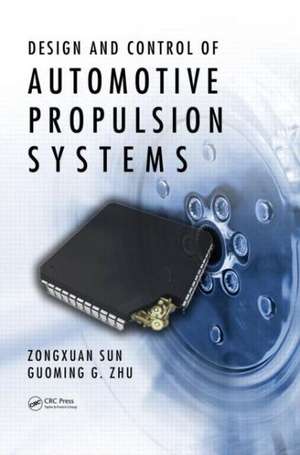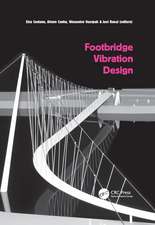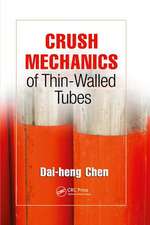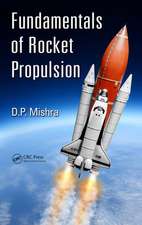Design and Control of Automotive Propulsion Systems
Autor Zongxuan Sun, Guoming G. Zhuen Limba Engleză Hardback – 20 dec 2014
While powertrain system design and its control integration are traditionally divided into two different functional groups, a growing trend introduces the integration of more electronics (sensors, actuators, and controls) into the powertrain system. This has impacted the dynamics of the system, changing the traditional mechanical powertrain into a mechatronic powertrain, and creating new opportunities for improved efficiency. Design and Control of Automotive Propulsion Systems focuses on the ICE-based automotive powertrain system (while presenting the alternative powertrain systems where appropriate). Factoring in the multidisciplinary nature of the automotive propulsion system, this text does two things—adopts a holistic approach to the subject, especially focusing on the relationship between propulsion system design and its dynamics and electronic control, and covers all major propulsion system components, from internal combustion engines to transmissions and hybrid powertrains.
The book introduces the design, modeling, and control of the current automotive propulsion system, and addresses all three major subsystems: system level optimization over engines, transmissions, and hybrids (necessary for improving propulsion system efficiency and performance). It provides examples for developing control-oriented models for the engine, transmission, and hybrid. It presents the design principles for the powertrain and its key subsystems. It also includes tools for developing control systems and examples on integrating sensors, actuators, and electronic control to improve powertrain efficiency and performance. In addition, it presents analytical and experimental methods, explores recent achievements, and discusses future trends.
Comprised of five chapters containing the fundamentals as well as new research, this text:
- Examines the design, modeling, and control of the internal combustion engine and its key subsystems: the valve actuation system, the fuel system, and the ignition system
- Expounds on the operating principles of the transmission system, the design of the clutch actuation system, and transmission dynamics and control
- Explores the hybrid powertrain, including the hybrid architecture analysis, the hybrid powertrain model, and the energy management strategies
- Explains the electronic control unit and its functionalities—the software-in-the-loop and hardware-in-the-loop techniques for developing and validating control systems
| Toate formatele și edițiile | Preț | Express |
|---|---|---|
| Paperback (1) | 351.68 lei 43-57 zile | |
| CRC Press – 26 iul 2017 | 351.68 lei 43-57 zile | |
| Hardback (1) | 933.23 lei 43-57 zile | |
| CRC Press – 20 dec 2014 | 933.23 lei 43-57 zile |
Preț: 933.23 lei
Preț vechi: 1330.07 lei
-30% Nou
Puncte Express: 1400
Preț estimativ în valută:
178.63€ • 194.10$ • 150.15£
178.63€ • 194.10$ • 150.15£
Carte tipărită la comandă
Livrare economică 21 aprilie-05 mai
Preluare comenzi: 021 569.72.76
Specificații
ISBN-13: 9781439820186
ISBN-10: 143982018X
Pagini: 218
Ilustrații: 169 black & white illustrations, 15 black & white tables
Dimensiuni: 178 x 254 x 15 mm
Greutate: 0.57 kg
Ediția:1
Editura: CRC Press
Colecția CRC Press
ISBN-10: 143982018X
Pagini: 218
Ilustrații: 169 black & white illustrations, 15 black & white tables
Dimensiuni: 178 x 254 x 15 mm
Greutate: 0.57 kg
Ediția:1
Editura: CRC Press
Colecția CRC Press
Public țintă
Professional Practice & DevelopmentCuprins
Introduction of the Automotive Propulsion System. Design, Modeling, and Control of Internal Combustion Engine. Design, Modeling, and Control of Automotive Transmission Systems. Design, Modeling, and Control of Hybrid Systems. Control System Integration and Implementation. References. Index.
Recenzii
"This book brings together the major propulsion system components with control oriented models and actuators to enable software and hardware-in-the-loop simulations. … This book will provide students with a detailed set of component models and simulation tools to learn Rapid Control Prototyping methods."
—Douglas J. Nelson, Professor of Mechanical Engineering, Virginia Tech
—Douglas J. Nelson, Professor of Mechanical Engineering, Virginia Tech
Notă biografică
Dr. Zongxuan Sun is an associate professor of mechanical engineering at the University of Minnesota, Minneapolis. He was a researcher from 2000 to 2007 at the General Motors Research and Development Center in Warren, Michigan. Dr. Sun received his BS in automatic control from Southeast University, Nanjing, China, in 1995, and his MS and PhD in mechanical engineering from the University of Illinois at Urbana-Champaign, in 1998 and 2000, respectively. He has published more than 90 refereed technical papers and received 19 U.S. patents. His research interests include controls and mechatronics with applications to the automotive propulsion systems.
Dr. Guoming (George) Zhu is a professor of mechanical engineering and electrical/computer engineering at Michigan State University. His BS and MS (1982 and 1984, respectively) were from Beijing University of Aeronautics and Astronautics in China. He has authored or coauthored more than 140 refereed technical papers and received 40 U.S. patents. He was an associate editor for ASME Journal of Dynamic Systems, Measurement, and Control and a member of the editorial board of International Journal of Powertrain. Dr. Zhu is a Fellow of the Society of Automotive Engineers (SAE) and American Society of Mechanical Engineers (ASME).
Dr. Guoming (George) Zhu is a professor of mechanical engineering and electrical/computer engineering at Michigan State University. His BS and MS (1982 and 1984, respectively) were from Beijing University of Aeronautics and Astronautics in China. He has authored or coauthored more than 140 refereed technical papers and received 40 U.S. patents. He was an associate editor for ASME Journal of Dynamic Systems, Measurement, and Control and a member of the editorial board of International Journal of Powertrain. Dr. Zhu is a Fellow of the Society of Automotive Engineers (SAE) and American Society of Mechanical Engineers (ASME).
Descriere
This book presents analytical and experimental methods and achievements in design, modeling and control of automotive propulsion systems. The text presents a systems view on the working principles of engines, transmissions and hybrids. It offers plenty of examples on designing key powertrain subsystems, developing models and controls for integrating and optimizing the powertrain system. It also presents future trends to address the stringent fuel economy and emissions requirement.









